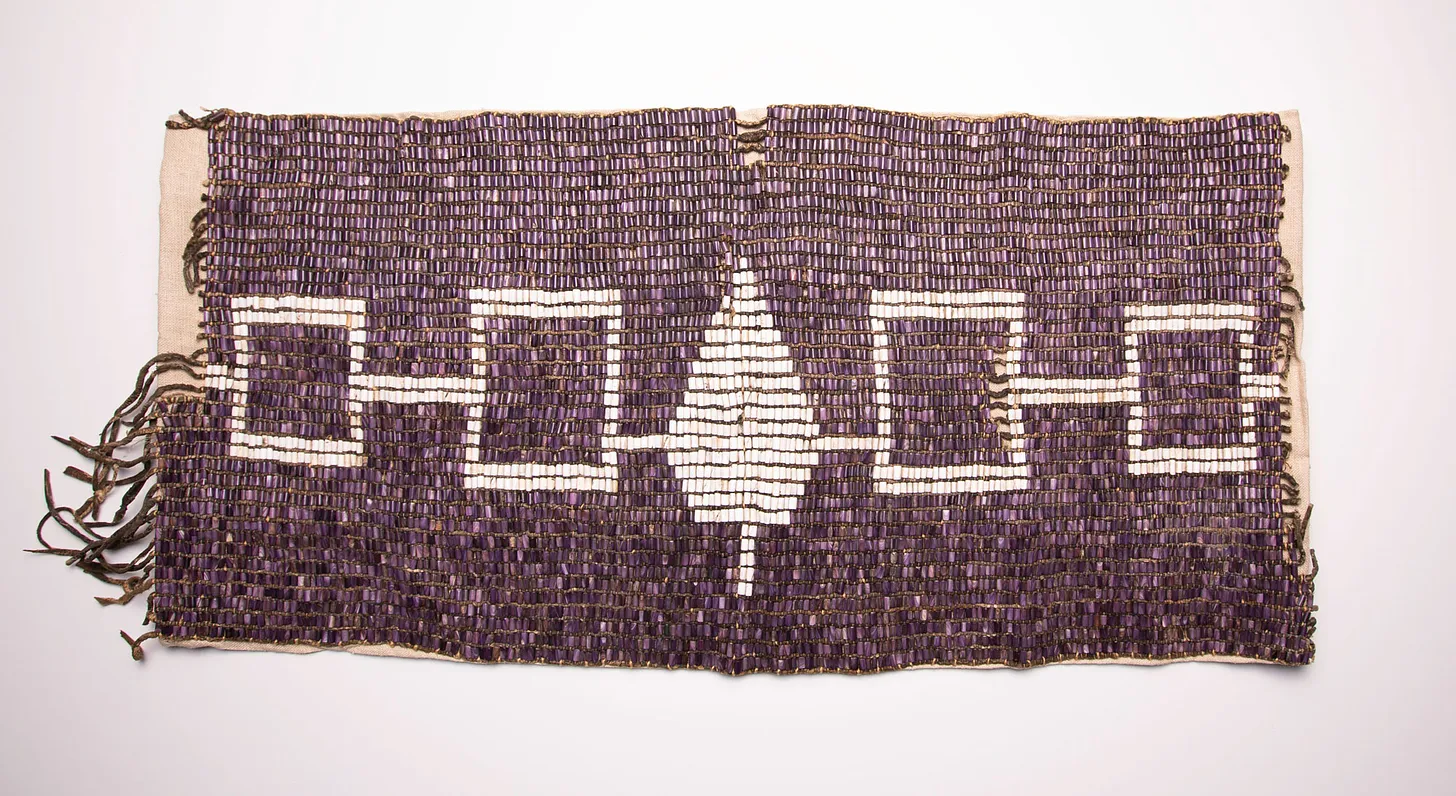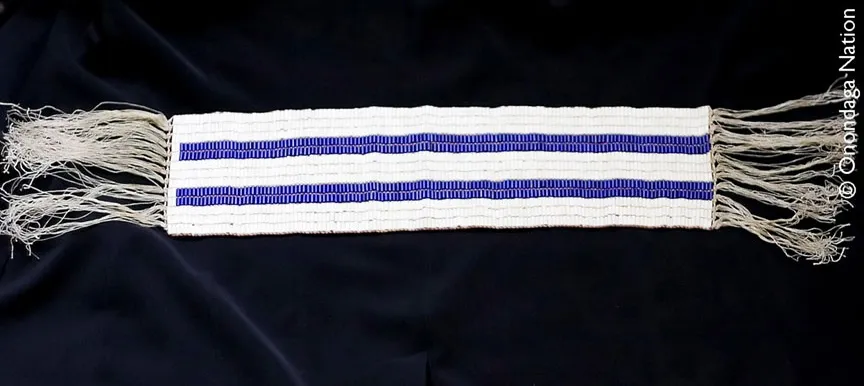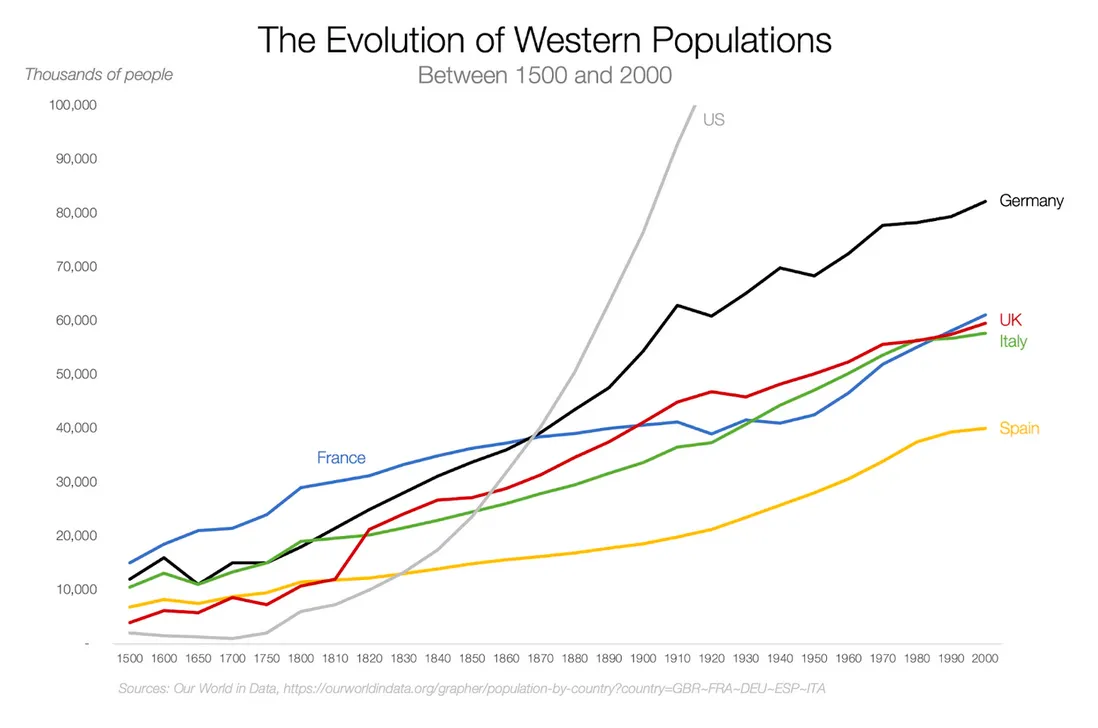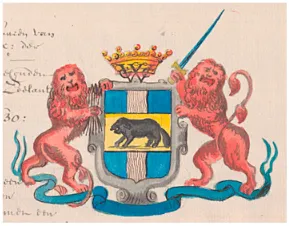The First NFTs Pre-existed the United States
"The first NFT was a long, beaded belt of white wampum with two parallel lines of purple beads."
At the time when Europeans made first contact with North Americans, beaded belts of wampum were something like blockchain tokens—employing proof of work as authentication of value. They were not really used as a substitute for barter, as Europeans then and many historians today still believe. Most were created to authenticate, certify and memorialize, like an NFT.1 The blockchain of the day was the oral history carried across generations by designated wampum keepers, persons given care of the belts who were worthy of maximum trust. In that way, wampum was like an entry into a platform based on proof of trust.
Chiefs of the Six Nations, after photo by Horatio Hale, 1871
Last week I wrote about the Onondaga Land Claim and in the process, I stumbled upon a historical mystery—the whereabouts of some beaded belts, including one known as Teioháte Kaswenta (Two Row Wampum). The story behind this and other belts continues to inform legal cases, diplomatic relations, history and art today.
When the Dutch East India Company, looking to trade for beaver pelts, sailed up the Hudson and encountered the Haudenosaunee2, they noticed that white shell-adorned belts, sashes, wristbands, moccasins and necklaces were common accessories for men, women and children and more valued than Dutch gold or silver. The most prized beads were brilliantly white, made of Knobbed Whelk and Channelled Whelk (Busycon carica and Busycotypus canaliculatus) brought inland by coastal Algonquian speakers such as the Munsees and Pequots of Long Island and Cape Cod, or by Penobscot and tribes along the coast of Maine. The term wampum is an anglicized truncation of the Algonquian term wampumpeag, which is perhaps a corruption of Wampanoag, a coastal nation that made beads from those shells more than 1000 years ago.
When the Great Law of Peace was enacted, Hiawatha designed the Five Nations wampum belt as beaded white squares signifying the Seneca, Cayuga, Oneida and Mohawk in geographical order with the Onondaga, at the center, represented by an eastern white pine—the Tree of Peace.
 |
Hiawatha belt |
Five months before he died in 2018, my friend Manitonquat, known to most as Medicine Story, sent me his favorite story, the Great Law of Peace.
The Peacemaker was born and grew among the Huron people. We who are not Haudenosaunee have heard that his name was Deganawida, but those people only call him the Peacemaker. When he began to have a vision of a Great Peace among all the nations, the fiercely independent Huron would hear none of it. So he traveled to other lands and found acceptance for his dream among the Kanayenkahaka, the People of the Flint, whom we call the Mohawk. They are the eastern guardian of those nations.
The central nation, which we know as the Onondaga, had been taken over by a powerful and dangerous magician called Todadaho. Another man of that nation, Hiawatha, came into conflict with the magician’s dictatorship, but the rest of his people were all afraid, so Hiawatha left them to seek another community. On his travels, he had several dreams that told him the five nations should unite and agree on peace among them.
***
The Kanayenkahaka encouraged the Peacemaker and Hiawatha to travel to the other four nations with their proposal. So they set out and enlisted the Oneida, the Cayuga, and the Seneca in the proposal for a union, saving the difficult task of the Onondaga under the power of the magician Todadaho for the last. They all went together in a great peace march, singing of the Great Peace to come.
***
Todadaho had snakes all over his head that secreted evil into his brain, so while Hiawatha spoke the Peacemaker began to comb the snakes out. When someone combs your hair it is very relaxing, and Todadaho was quieted and open to hearing Hiawatha.
“O Great Todadaho,” Hiawatha crooned, “wise and powerful war leader of the nation, you are the greatest of warriors. But now we have a vision of far greater power for you. As great as you are in war, we see an even greater future for you in the much more difficult arts of peace in which no one has been successful. As the head of the center of the five nations, you could institute a Great Law of Peace that would unite them and make them live while all other nations die away, and your honor would remain for all time, your wisdom sung by many generations to come.”
Of course, Todadaho was won over, not just by the flattery, but by the vision of his leadership in a Great Peace. So it was that the Onondaga became the center of this league of nations, and the man who leads the league from there today is still called by the title of Todadaho.
Hiawatha is said to have introduced wampum to the Peacemaker after the former’s wanderings along the Eastern Seaboard. The Peacemaker employed wampum designs to keep his teachings and they became the oral constitution or Gayanashagowa. The original five member nations ratified this constitution in council near present-day Victor, New York, perhaps 500 years ago, maybe longer, with the Tuscarora later joining in 1722.
Included in that constitution, passed to this day by storytellers who interpret the wampum belts, is a system of government whereby the League is governed by a Grand Council—an assembly of fifty chiefs or sachems, each representing one of the clans of one of the nations. Most Iroquoian peoples have a matrilineal kinship system—descent passing through the maternal lines—and children are considered born into their mother’s clan. Their clan mothers, or elder women of each clan, are highly respected. The women of a clan nominate the chief for life, own the symbols of his office, and can remove him if he disgraces himself. The wampum designed by the Great Peacemaker and made by Hiawatha provided ways to settle grievances, make decisions of state, and rituals of social healing. These “NFTs” are still employed in longhouse councils today.
Historian Kathryn Muller writes:
Without the belt's accompanying discourse, the historian would simply examine an expressive object, rich in color and pictographic symbolism but lacking in elaboration. Too often, however, the historical value of the oral tradition of wampum belts is ignored by academics who consider it to be unreliable. For example, political scientist and author Tom Flanagan doubts the accuracy of oral tradition since it “is a memory of a memory and depends on person-to-person telling and retelling, which offers more opportunities for omission, distortion and error to creep in.” Furthermore, William Fenton, an eminent scholar of the Six Nations, asserts that since the frequent reading of a belt is necessary to maintain the precision of the message, belts retained for decades in museums, far away, lose credibility.
Cayuga Chief Jake Thomas argues with this idea that “proof of trust” messages lose fidelity. He says that elders carefully instructed younger keepers of the wampum in the precise memorization of stories, preparing them to become spokespeople of their nations. “When you pass it on, you don't try to use your own ideas, because if you do, you get people confused.”
The Colombian Encounter
Although the first European explorers incorrectly assumed wampum was an indigenous form of money, they were not far wrong, in that all Eastern Woodland Indians practiced some form of gift economy and social reciprocity. Gift-giving resolved differences and cemented relationships between individuals and groups. When the Dutch and French began bringing colored glass beads to trade, and iron drills, they had scant conception of how valuable those were, or how much their gesture would be appreciated. Those beautiful little bits of colored glass might even be worth taking in trade for an entire island at the mouth of the Hudson.
Explorer Jacques Cartier recorded in 1535 that
the most precious thing that they have in this world is esnogny, which is white as snow.
The esnogny referred to was likely the polished whelp shells. When Cartier returned in 1541, as he had promised, he was greeted by a chief who
took a piece of tanned leather of a yellow skin edged about with esnogny ... which was upon his head instead of a crown, and he put the same on the head of our captain, and took from his wrists two bracelets of esnogny, and put them upon the captain’s arms.
Cartier was being introduced to the gift economy, although he failed to grasp its significance.
Cornell University’s Jon Parmenter records that the Iroquois employed a method of weaving that permitted side-to-side stringing of short tubular white whelk shells and dark-colored tubular beads for geometrical designs and representational images. The availability of European-supplied iron drills came later, but examples of purple wampum of quahog shell have been dated to 1605.
Wampum recorded other important agreements, such as the 1701 Dish with One Spoon Treaty between the Haudenosaunee and the Anishinaabe peoples or the 1722 admission of the Tuscarora to the League. These belts were not currency—they were tokens admitting new groups to participate. According to Muller,
White wampum symbolized “peace, desire for understanding, and sociability,” while purple, dark, or black wampum “conveyed a semantic context of death, mourning, and associability.” A wampum belt colored red reflected “high emotion and excitement and the ultimate expression of antisociability: war.” … Many belts, perhaps even the majority that survive today, combine both purple and white beads in their pictographs, and many of these definitely represented friendly relations between Europeans and Natives.
***
While such pictographs and color symbolism allowed Native chiefs and European colonial officials to circumvent early language barriers and understand the bare bones of the message (peace/friendship or war), a much more complex explanation could only be developed with an interpreter….
In 1613 there was perhaps one of the most significant parlays ever to occur, between unnamed Mohawks and a Dutch trader named Jacob Eelckens at Tawagonshi. Its memory is retained in Haudenosaunee oral history as the Gä•sweñta’ or Kaswentha. Parmenter describes it this way:
The underlying concept of kaswentha emphasizes the distinct identity of the two peoples and a mutual engagement to coexist in peace without interference in the affairs of the other. The Two Row Belt, as it is commonly known, depicts the kaswentha relationship in visual form via a long beaded belt of white wampum with two parallel lines of purple wampum along its length – the lines symbolizing a separate-but-equal relationship between two entities based on mutual benefit and mutual respect for each party’s inherent freedom of movement–neither side may attempt to “steer” the vessel of the other as it travels along its own, self-determined path.
 |
| The Two Row Belt |
The Onondaga Nation website describes the Kaswentha this way:
After many discussions, it was decided that the Haudenosaunee and the Europeans must have a way to greet each other when they meet. The settlers with their large sailed boat thought that they should be called “Father” and the Haudenosaunee “Son.” The Haudenosaunee said that this would not do. “We shall address each other as ‘Brothers.’ This shows that we are equal to each other.”
As the Haudenosaunee and Dutch discovered much about each other, an agreement was made as to how they were to treat each other and live together. Each of their ways would be shown in the purple rows running the length of a wampum belt. “In one row is a ship with our White Brothers’ ways; in the other a canoe with our ways. Each will travel down the river of life side by side. Neither will attempt to steer the other’s vessel.”
Besides in their Council gatherings, Haudenosaunee speakers recited the Kaswentha tradition for Anglo-American and French colonial audiences on at least fifteen recorded occasions between 1656 and 1744 with “a striking degree of consistency.”
A nineteenth-century French dictionary of the Mohawk language defined the very word for wampum belt (kahionni) as a human-made symbol emulating a river, due in part to its linear form and in part to the way in which its constituent shell beads resemble ripples and waves. Just as a navigable water course facilitates mutual relations between nations, thus does kahionni, “the river formed by the hand of man”, serve as a sign of “alliance, concord, and friendship” that links “divergent spirits” and provides a “bond between hearts”
The Haudenosaunee on the US side of the border used their Two Row Wampum to resist the Indian Citizenship Act, the Selective Service Act and the Internal Revenue Service Act. Before allowing their young men to join the army in 1942, the Grand Council made a separate declaration of war against the Axis powers that they forwarded to Franklin Roosevelt. In Canada, the 1996 Royal Commission on Aboriginal Peoples described the Two Row as “a model of parallelism with which to guide Canadian-Aboriginal relations.”
Art historian Laura Brandon observes:
It is considered a living treaty, and its alternating rows of purple and white shell beads represent the two parties to the treaty moving forward together in parallel, but never merging, signifying respect for each other’s rights. Of the five rows, the first of three white ones denotes peace, the second, friendship, and the third, perpetuity. One of the two purple rows symbolizes European leaders, government, and religion in a sailboat, while the second purple row signifies a canoe conveying Indigenous leaders, their government, and their way of life.
The official seal of the New Netherland colony, probably adopted in 1630 (the date of the original deed of the patroonship of Rensselaerswijck), featured a beaver on a background of the Two Row wampum.
It may be comforting to imagine a different scenario that could have unfolded. When approached by the Dutch in 1613, the Haudenosaunee welcomed them with gifts and established that the newcomers were their guests. Had the Haudenosaunee not later ceded—by treaty, coercion and outright theft—vast lands from the St. Lawrence to the Delaware River, there could today be wolves, bears and cougars in the Allegheny and Pocono Mountains. Beavers would still be there. The ecology of the region might still be relatively intact, resilient and regenerative.
 |
Pueyo, T., Uncharted Territories, June 2, 2022 |
From first landfall, conflict between East and West was inevitable. The Haudenosaunee, as formidable as they were, had neither army nor weapons sufficient to repel such an invasion. Suing for peace provided little respite.
A wave of human flesh enveloped and decimated the entire natural ecology of the Western Hemisphere. Poor stewardship was just one outward manifestation. It was population that killed the continent. Many invasive species were introduced, but the most dangerous of them had two legs.
Until almost the end of the 19th century, some of the most important belts of the Haudenosaunee, and the stories they told, resided in the possession of just a few trusted wampum keepers. As these began to die, it was as though the “NFTs” they represented were deprived of power.
Syracuse Journal July 5, 1897:
Chief Thomas Webster, the keeper of the wampum of the Iroquois confederacy, is dead. This death takes the last of the aged keepers of the wampum of the Six Nations Confederacy. Upon the 28th of February, 1895, Abraham Hill, the keeper of the wampum of the Younger Brothers died. The office of wampum keeper is one of the most ancient in the Confederacy. The Websters are mentioned among the most noted chiefs of the Onondagas of recent years. They are the descendants of the marriage of Ephraim Webster, Onondaga's first settler, with an Indian. These descendants have always lived with the Onondagas. Harry Webster, one of Ephraim Webster's children, was long a chief of high reputation. Thomas Webster came from this same family.
There are some stories afloat about the recent disappearance of wampum from the keeping of Chief Webster. The chief kept this wampum under his bed in his hut on the reservation. Now it is said that some of the most valuable pieces of it are missing. Three years ago, at the time of the Onondaga Historical Association loan exhibition, this wampum was exhibited in the charge of Chief Webster. They were returned, and some of the most valuable pieces are said to have been missed and turned up in the collections at the State museum and the Smithsonian Institution. The Mayor of Albany is said to have come into possession of a very valuable piece called the Hiawatha belt. The question is how did these belts disappear?
This is the first of several parts. Next week we’ll try to find out where the wampum went.
References
Barriero, J., Indian Roots of American Democracy, NY Albany Museum: 1990
Berman, Howard R., “Perspectives on American Indian Sovereignty and International Law, 1600 to 1776,” in Oren R. Lyons and John C. Mohawk (eds.), Exiled in the Land of the Free: Democracy, Indian Nations, and the U.S. Constitution (Santa Fe, N.M.: Clear Light Publishers, 1992), p. 135
Brandon, Laura, Art and War. Bloomsbury Publishing, 2012
Dunn, R., J. Savage, and L. Yeandle (eds.), Journal of John Winthrop. Harvard University Press, 1996
Getty, Ian A.L. and Antoine S. Lussier (eds.), As Long as the Sun Shines and Water Flows: A Reader in Canadian Native Studies. Vancouver: University of British Columbia Press, 1983
Kennedy, A., The Importance of Gaining and Preserving the Friendship of the Indians to the British Interest Considered (New York, 1751)
Lopez, A., Pagans in Our Midst, Akwesasne Notes: 1977
Muller, Kathryn V., The Two “Mystery” Belts of Grand River, American Indian Quarterly 31:1 Winter 2007
Otto, Paul, and Jaap Jacobs. "Early Iroquoian–European Contacts: The Kaswentha Tradition, the Two Row Wampum Belt, and the Tawagonshi Document." Special issue, Journal of Early American History 3 (2013): 1. DOI 10.1163/18770703-00301005
Parmenter, Jon, The Meaning of Kaswentha and the Two Row Wampum Belt in Haudenosaunee (Iroquois) History: Can Indigenous Oral Tradition be Reconciled with the Documentary Record? (State University of New York, 2013)
_____, “Separate Vessels: Iroquois Engagements with the Dutch of New Netherland, circa 1613-1664”, forthcoming in Jaap Jacobs and L.H. Roper (eds.), The Worlds of the Seventeenth-Century Hudson Valley (Albany, N.Y.: State University of New York Press, 2014).
Varia, Original deed of the patroonship of Rensselaerswijck, 13 August 1630, New York Public Library
Notes
[2] The word Haudenosaunee means "people of the longhouse" and will be used in this text as the preferred name of the Haudenosaunee people themselves, instead of the French/English term, Iroquois. The League originally was comprised of five nations (the Mohawks, Oneidas, Onondagas, Cayugas, and Senecas) and the Tuscaroras joined as the sixth nation when they migrated north in the early eighteenth century.
_____________________
Towns, villages and cities in the Ukraine are being bombed every day. As refugees pour out into the countryside, they must rest by day so they can travel by night. Ecovillages and permaculture farms have organized something like an underground railroad to shelter families fleeing the cities, either on a long-term basis or temporarily, as people wait for the best moments to cross the border to a safer place, or to return to their homes if that becomes possible. So far there are 62 sites in Ukraine and 265 around the region. They are calling their project “The Green Road.”
The Green Road also wants to address the ongoing food crisis at the local level by helping people grow their own food, and they are raising money to acquire farm machinery, seed, and to erect greenhouses. The opportunity, however, is larger than that. The majority of the migrants are children. This will be the first experience in ecovillage living for most. They will directly experience its wonders, skills, and safety. They may never want to go back. Those that do will carry the seeds within them of the better world they glimpsed through the eyes of a child.
Those wishing to make a tax-deductible gift can do so through Global Village Institute by going to http://PayPal.me/greenroad2022 or by directing donations to greenroad@thefarm.org.
There is more info on the Global Village Institute website at https://www.gvix.org/greenroad
The COVID-19 pandemic has destroyed lives, livelihoods, and economies. But it has not slowed down climate change, which presents an existential threat to all life, humans included. The warnings could not be stronger: temperatures and fires are breaking records, greenhouse gas levels keep climbing, sea level is rising, and natural disasters are upsizing.
As the world confronts the pandemic and emerges into recovery, there is growing recognition that the recovery must be a pathway to a new carbon economy, one that goes beyond zero emissions and runs the industrial carbon cycle backwards — taking CO2 from the atmosphere and ocean, turning it into coal and oil, and burying it in the ground. The triple bottom line of this new economy is antifragility, regeneration, and resilience.
Help me get my blog posted every week. All Patreon donations and Blogger or Substack subscriptions are needed and welcomed. You are how we make this happen. Your contributions are being made to Global Village Institute, a tax-deductible 501(c)(3) charity. PowerUp! donors on Patreon get an autographed book off each first press run. Please help if you can.
#RestorationGeneration #ReGeneration
“There are the good tipping points, the tipping points in public consciousness when it comes to addressing this crisis, and I think we are very close to that.”
— Climate Scientist Michael Mann, January 13, 2021.
Want to help make a difference while you shop in the Amazon app, at no extra cost to you? Simply follow the instructions below to select “Global Village Institute” as your charity and activate AmazonSmile in the app. They’ll donate a portion of your eligible purchases to us.
How it works:
1. Open the Amazon app on your phone
2. Select the main menu (=) & tap on “AmazonSmile” within Programs & Features
3. Select “Global Village Institute” as your charity
4. Follow the on-screen instructions to activate AmazonSmile in the mobile app



Comments